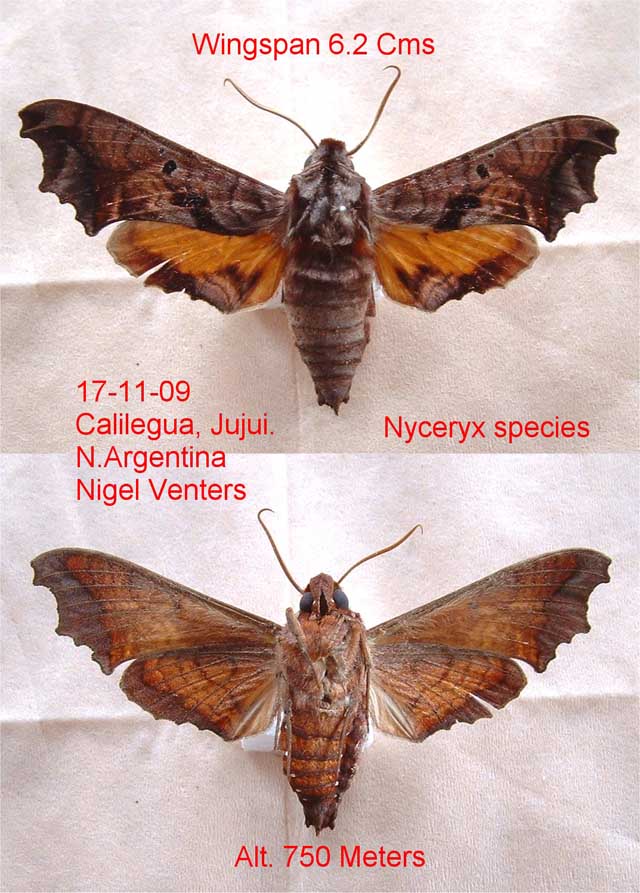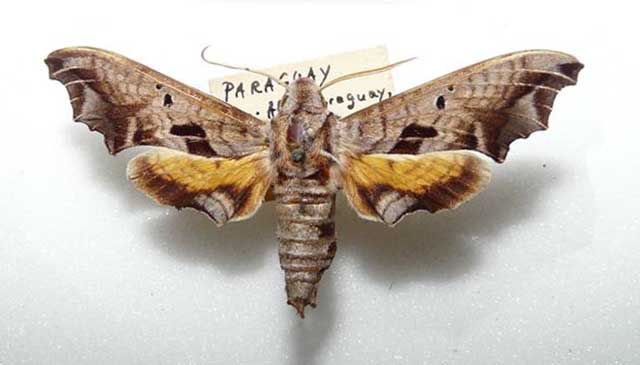Nyceryx furtadoi
Haxaire, 1996

Nyceryx furtadoi,
Pair: Paratype male 60 mm; female 60 mm. September-October,
Reserva Vale da Solidão, 14o22’S
56o07’W, 450 m, Diamantino, Mato Grosso, Brazil,
courtesy of Eurides Furtado.
This site has been created by
Bill Oehlke at oehlkew@islandtelecom.com
Comments, suggestions and/or additional information are welcomed by Bill.
TAXONOMY:
Family: Sphingidae, Latreille, 1802
Subfamily: Macroglossinae, Harris, 1839
Tribe: Dilophonotini, Burmeister, 1878
Genus: Nyceryx Boisduval, [1875] ...........
Species: furtadoi Haxaire, 1996
|
MIDI MUSIC
.....It's a Wonderful World.....
copyright C. Odenkirk
ON.OFF
<bgsound src="world.mid" LOOP=FOREVER>
|
DISTRIBUTION:
Nyceryx furtadoi
flies in
Brazil: Goiás; Mato Grosso; Mato Grosso do Sul,
the specimen type locality;
Bolivia: Santa Cruz (1000-1650m) and
Paraguay: Central: San Lorenzo; Alto Paraguay; and
possibly in Argentina: Jujuy: Calilegua, probably Salta.

Nyceryx furtadoi, 62mm, Calilegua, Jujuy, Argentina,
November 17, 2009, 750m, courtesy of Nigel Venters,
tentative identification by Bill Oehlke.
FLIGHT TIMES:
Moths are probably on the wing in just
about every month. The Paratype male was taken in September-October.
Paul Smith reports an August flight in San Lorenzo, Central, Paraguay.

Nyceryx furtadoi, San Lorenzo, Central, Paraguay,
August, 2009, courtesy of Paul Smith.
ECLOSION:
Adults eclose, usually within three weeks.
SCENTING AND MATING:
Females call in the males with a
pheromone released from a gland at the tip of the abdomen.
I am not sure if the following characters are consistent or even relevant, but differences between
N. alophus and N. furtadoi which are sympatric is some areas (San Lorenzo, Central, Paraguay) include the following:
N. furtadoi has a) more pronounced/produced scalloping of the forewing outer margin; b) less dentate fw pm lines;
C) a more upright white bar extending from the inner margin near the anal angle, only about a third of the way up the wing;
D) a lighter, more even ground colour to the forewing; and E) a larger, rounder black fw cell marking, with a smaller accessory black
mark just below the costa.
In N. alophus the white bar is more oblique and extends all the way up to the inside of the cell mark, which tends to be thin
more linear/streak-like) with a greatly reduced secondary mark.
EGGS, LARVAE, PUPAE:
Larvae feed on
Return to Sphingidae Index
Return to Dilophonotini Tribe
Goto South American Index


